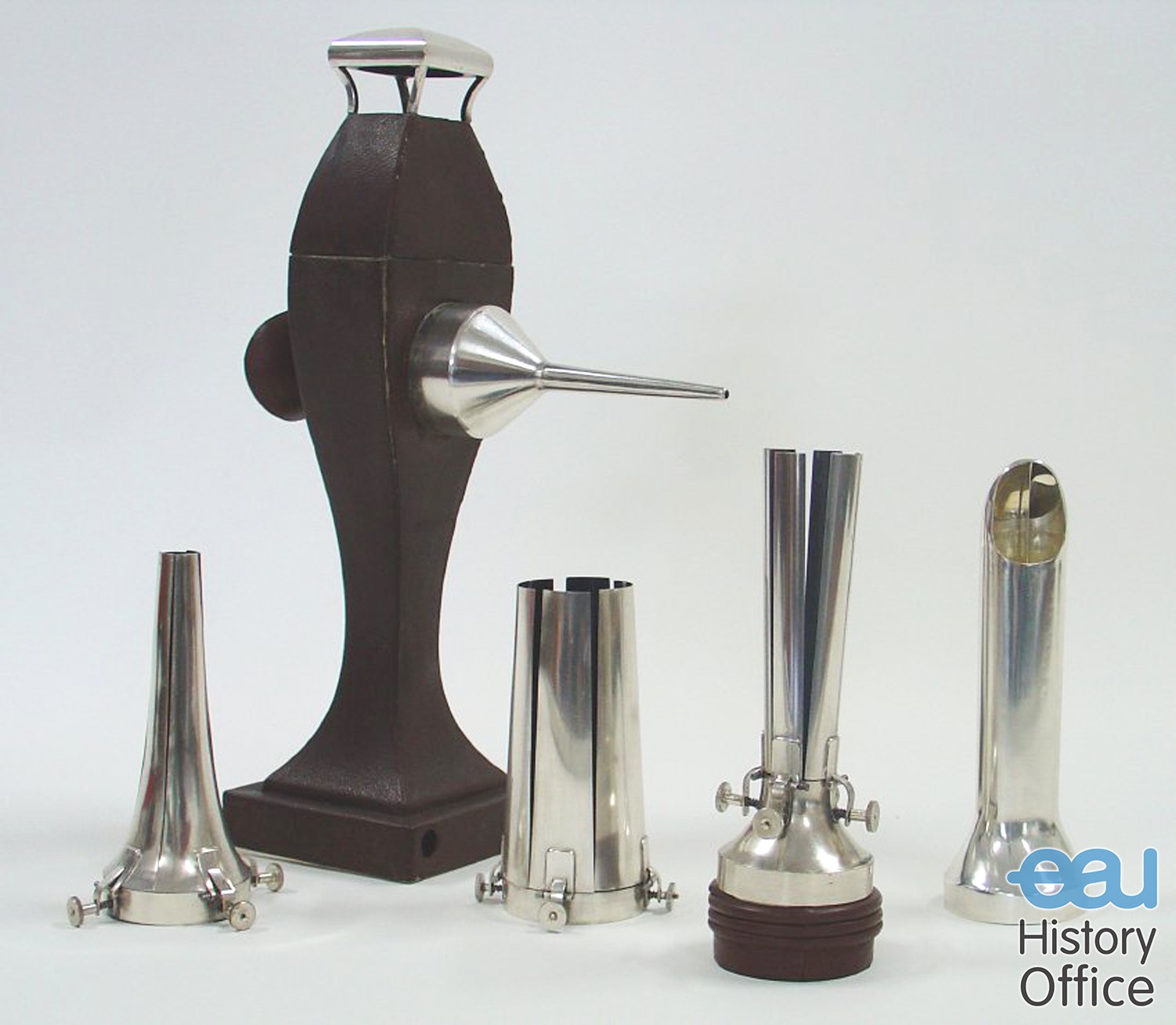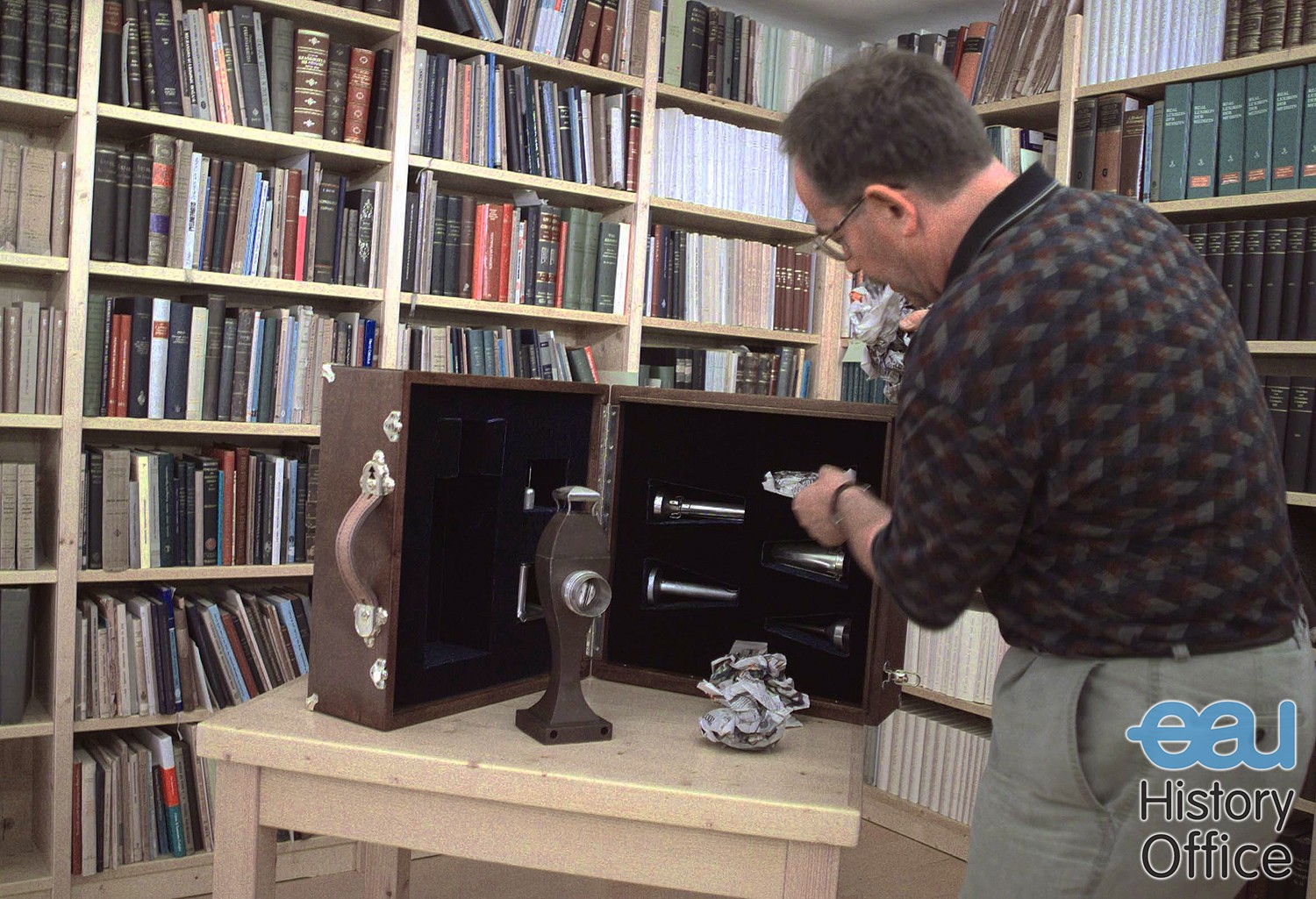Introducing the proto-endoscope
In 1804 the young physician Philipp Bozzini (1773-1809) published a first description of his “light conductor” in a small Frankfurt daily paper. Further announcements and scientific articles followed shortly. The light conductor (Lichtleiter) enabled the direct view into the living body and had already incorporated the techniques of earlier attempts to overcome the major challenges of endoscopy, namely the problems of light, optics and handling. It consisted of an optical part with the illumination device and a mechanical part which had to be modified to fit to the anatomy of the respective body opening.
In 1806, Bozzini demonstrated his Lichtleiter on living patients to a group of university professors and physicians at the private maternity institute of Professor Ludwig Friedrich von Froriep (1779-1847) at Halle. After the successful inspection of the vagina, Froriep was quite enthusiastic about the instrument and asked Bozzini to have a Lichtleiter made for him. Further demonstrations followed at Frankfurt and Salzburg. Bozzini’s Lichtleiter generated a lot of interest at the time and caused all manner of controversial reactions within the scientific community. On the one hand there was a lot of enthusiasm and praise, and on the other hand critical voices judged his invention to be impracticable, not useful and even dangerous.
Bozzini’s original light conductor with specula. In December 1806 Bozzini’s light conductor was presented to the professors of the Josephinum, the “Medical-Surgical Joseph’s Academy” in Vienna. Created by Gottfried Wiesner, Leipzig. (Int.Nitze-Leiter Reserach Society for Endoscopy/Nitze-Leiter Collection)
The light conductor, or Lichtleiter, consists of two parts: (a) the light container with the optical device and (b) the mechanical part with the viewing tubes which are fitted to accommodate the anatomical access of the organs to be examined. The instrument is about 35 cm high, shaped like a vase and made out of hollow lead, covered with leather. A round opening on its front side is vertically divided in two parts. In one half, a wax candle is placed and held by an arrangement of springs so that the flame is always in the same position. Concave mirrors are placed behind the candle and reflect the light of the candle through the one half of the tube to the eye of the observer. A concave lens is placed on the side towards the “Lichtleiter”.
According to the width of the cavities to be examined, i.e. the ear, the urethra, the female urinary bladder, gunshot tracts, etc. different specula were used. These specula consist of blade-shaped prongs which could be spread open by using a screw device in order to expand the channels.
In this Frankfurt model light conductor by Philipp Bozzini, the two tubes for light and image transport lie side-by-side. This explains why the opening for the ocular is located off-centre (more to one side) on the back wall of the light receptacle; this is typical of the Frankfurt light conductor.
Light and image transport are separated in the light receptacle by inserting the so-called reflection tube. The reflection tube ensures that the light emitted by the light source does not interfere with image transport; in addition, the reflection tube divides the opening on the front wall, to which the various examination shafts are attached, for light transport and image transport.
Complete separation of the channels for light and image transport was necessary in Bozzini’s light conductor only when the “tube for angular light transport” (a laryngoscope shaft) was used; this was a shaft in which the direction of light or image transport at the shaft tip was deflected 90° by means of a mirror.
 Technical drawing of Bozzini’s light conductor which was first published in 1804. From the Int.Nitze-Leiter Research Society for Endoscopy/Nitze-Leiter Collection.
Technical drawing of Bozzini’s light conductor which was first published in 1804. From the Int.Nitze-Leiter Research Society for Endoscopy/Nitze-Leiter Collection.
Bozzini’s instrument, in his own words…
The Light Conductor
The main requirements for looking into the internal cavities of the living body are therefore:
I. To introduce a sufficient amount of light into these cavities.
II. To bring the reflecting light-rays back to the eye of the examiner.
To fulfill the first requirement you need
a) a physiological or pathological orifice
b) a light container
c) light conducting tubes
To fulfill the second requirement you need an additional tube for the reflecting the light rays – which I call for the sake of distinction – reflecting tube.
Excerpt: Philipp Bozzini’s “Lichtleiter, eine Erfindung zur Anschauung innerer Theile und Krankheiten”, in Journal der praktischen Heilkunde, Berlin 1806.
The Light Sheath
One of the main requirements of the light is that the flame is kept with constant intensity at the same position. A wax candle which is stuck in a sheath made of iron or sheetbrass seems perfect to me…
The Light-Conducting Tubes
Since these tubes bring the light into the cavities of the living body they should have the following properties:
1) They must be light enough to introduce them without any discomfort into the physiological or pathological orifices.
2) Since the cavities are mostly pressed together one would only see a small spot, if the shape of the tube should not be variable…
3) The different cavities of the living body require different tubes. The shape and size of the tube is subject to the individual cavity to be examined.
4) The tubes must give passage to the light and must permit excellent reflection of the light as well.
5) After being introduced into the cavities, the tubes must be fixed on the middle part of the light containers.
In order to reach all these requirements I have classified the tubes into three categories:
1) tubes for big cavities (e.g. vagina, uterus after delivery etc…)
2) tubes for small orifices,
3) tubes which permit the view to not straight (oblique) directions.
Excerpt: Philipp Bozzini, Der Lichtleiter, Weimar, 1807
Upon request of Anton von Beinl (1749-1820), director of the Viennese medico-surgical Joseph’s Academy, Bozzini sent his Lichtleiter to Vienna in November 1806. The trials, which were immediately carried out by a group of experts at the Joseph’s Academy, revealed some technical constraints. The Joseph Academy would develop its own improved version.
Based on the most recent research done by the urologist Peter Paul Figdor from Vienna, Bozzini’s light conductor was probably the most frequently used endoscope during the first quarter of the 19th century and it was even in use up to the mid 19th century. The original Bozzini Lichtleiter, which sustained quite a turbulent fate throughout its 200 years of existence, can be visited today at the Nitze-Leiter Museum of Endoscopy in Vienna.
The peregrinations of the Lichtleiter and its glorious return to Vienna
The famed Bozzini Lichtleiter, which was kept at the Josephinum in Vienna for more than 100 years, disappeared in 1945 during the occupation of Vienna by Allied forces. What had happened to this precious historical witness of the beginnings of endoscopy?
It turned out that the Bozzini Lichtleiter had undergone a long journey. Its re-emergence a couple of decades later caused somewhat astonishment. Dr. Irving Bush from Cook County Hospital, Chicago, found the instrument in a cardboard box together with several other surgical tools in the basement of the old Headquarters of the American College of Surgeons (ACS) in Chicago. He took it home, cleaned it, and displayed it on his TV set for several years. In 1971 and 1992, the Bozzini Lichtleiter was given on loan to the colleagues of the American Urological Association (AUA) to be displayed at several exhibitions at the associations’s annual meetings.
However, it became more and more evident to the history addicts among the American urologists, that this instrument had to be displayed at a museum of urology. Dr. Rainer Engel, the curator of the William P. Didusch Museum in Baltimore and a connoisseur of the history of urology from its beginnings, was the driving force behind the several attempts to rescue the Lichtleiter from the American College of Surgeons. His personal accounts appear like a thriller:
“In 1996, upon my return from a trip to Vienna, I wrote the curator of the collections of the American College of Surgeons (ACS) with my plea to initiate proceedings to return the instrument to Vienna. I received a very blunt reply indicating I was out of my head to even suggest such a preposterous idea. The refusal was absolute. Sometime later I contacted the curator’s secretary to see if there was any way I could change the good man’s opinion, but she was very clear in interpreting his feelings and thought I would get the instrument only over his dead body. Subsequently, he died. I can assure you there was no causal relation.”
The official handing over of the Bozzini Lichtleiter should take place another six years later. On the occasion of the annual meeting of the AUA in Orlando in May 2002, the representatives from the American College of Surgeons (ACS) and from the Board of Directors of the AUA met at the annual History Forum. The highlight of this meeting was the handing over of the Lichtleiter from the ACS through the AUA to Dr. Manfred Skopec from the International Nitze-Leiter Research Society of Endoscopy in Vienna.
Excerpt: Peter Paul Figdor: “A few words of introduction on the celebration marking the return of Bozzini’s light conductor to Vienna”. In: The Development of Endoscopy in the 19th Century, Vol 3., Tuttlingen, 2004.
Inspection of Lichtleiter upon return to Vienna: Upon arrival at the Josephinum in Vienna, Dr. Skopec immediately presented the Lichtleiter which finally had returned to Europe.



